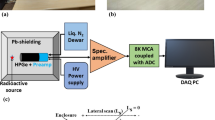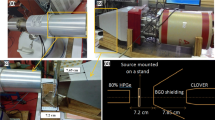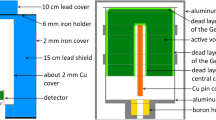Abstract
The high-purity germanium (HPGe) detectors, which are one of the basic instruments in the experimental nuclear physics, are widely used in many areas such as the environmental radioactivity, neutron activation analysis and geology. This study reports the results of energy calibration, energy resolution and efficiency calculations for an HPGe detector (ORTEC), which are necessary to determine the quality of the measurement results obtained from a gamma spectrometry system. For the purpose of examining the effects of gamma-ray energy and the distance between the source and the detector on the detector efficiency, measurements were made at six different source–detector distances for a total of about fourteen energies of the point sources (133Ba, 109Cd, 137Cs, 57Co, 60Co, 152Eu, 22Na, and 65Zn). Basic data were obtained with this detector system for later studies.
Similar content being viewed by others
Avoid common mistakes on your manuscript.
1 Introduction
Gamma-ray spectrometry with the germanium detectors is a non-destructive technique widely used to determine the activity concentrations of natural and artificial radionuclides in the environment [1,2,3]. The most important step in measurements made using a gamma-ray spectrometer is to determine the number of photons released from the source and absorbed by the detector. The detector efficiency refers to the ability of a detector to accurately and reliably detect and measure gamma radiation emitted by a radioactive source. The ability to precisely detect and measure gamma-ray radiation released from radioactive sources is dependent on a variety of efficiency types, including intrinsic, photopeak, relative, and absolute efficiencies [4].
The quality of the results measured by gamma-ray spectrometry directly depends on the accuracy of the detection efficiency of the detector under certain measurement conditions, and the energy resolution is also one of the important parameters to be determined [5, 6]. The efficiency of a detector system largely depends on parameters such as the energy of gamma-rays, detector dimensions, source dimensions, the geometric layout of the detector and source, and the density of the sample. Therefore, the efficiency calibration performed for one detector may not be applicable for another detector [7]. The most reliable method is to use experimental techniques in the relevant field to calculate the efficiency calibration for each detector system. The efficiency depends on the gamma energy, the detector and the measurement geometry [8].
Eight standard gamma point sources (133Ba, 109Cd, 137Cs, 57Co, 60Co, 152Eu, 22Na and 65Zn) were used to characterize the gamma-ray spectrometer with an HPGe detector at the Environmental Radioactivity Measurement and Research Laboratory, Department of Physics, Istanbul University, at various source–detector distances. The photopeak efficiency values of the detector were calculated, and calibration curves were created from these obtained data. The detector resolution values were also determined and compared with the values in the detector specifications.
2 Materials and methods
Gamma-ray point sources of different energies were used to characterize the gamma-ray spectroscopy system with HPGe detector at the Environmental Radioactivity and Measurement Laboratory of Istanbul University.
This system includes a p-type HPGe gamma-ray detector (ORTEC) with 35% of efficiency relative to NaI and an energy resolution of 1.85 keV at the 1.33 MeV energy of the gamma line in 60Co decay, a multi-channel analyzer (DSPEC jr 2.0), and a mechanical cooler (X-COOLER III) (Fig. 1). This detector can measure gamma-ray energies between 40 keV and 10 MeV [9] (Fig. 2).
The HPGe detector configurations and characteristics as specified by the manufacturer are given in Table 1.
All measurements for the energy and efficiency calibration of the gamma spectrometer system were measured with eight different standard gamma sources of 133Ba, 109Cd, 137Cs, 57Co, 60Co, 152Eu, 22Na, 65Zn with point source geometry. These measurements were performed at six different detector–source distances of 0, 3, 6, 9, 12 and 15 cm for each radionuclide for 900 s. The energies of these point sources are between 81 and 1408 keV.
The information of the sources with point source geometry used in the measurements for the characterization of the HPGe detector is given in Table 2. The radionuclides activities and uncertainties in these table are the values reported by the source manufacturer. GammaVision 6.2 (ORTEC) software was used for the acquisition and analysis of the spectra [9]. The statistical errors were taken into consideration in calculating the uncertainties in the measurements.
The photopeak efficiency of the HPGe detector was determined from the measured spectra by dividing the counts per second under the relevant peak area for each detector–source distance by the known radionuclide activity and gamma decay rate.
where N is the net counts under the photopeak at energy E, which are obtained by subtracting the counts associated with the underlying continuum from the total counts, A is the activity concentration of the radionuclide, \({I}_{\gamma }\) is the gamma-ray intensity, and t is the measurement time.
The resolution provides separation for two adjacent energy peaks, which leads to the identification of different radionuclides in the spectrum. It can be defined as the power to separate the energy peaks in the spectrum. The energy resolution of the detector was determined by calculating the full width at half-maximum (FWHM) of the peaks.
R is the energy resolution of the detector, and \({E}_{o}\) is the energy of the peak center of the related radionuclide.
3 Results and discussion
3.1 The determination of HPGe detector resolution
First of all, the energy calibration of the system was performed with radioactive sources in order to convert the channel number to the energy scale before using it in the detection of radiation in various samples with gamma-ray spectrometry.
The channel numbers corresponding to the photopeaks created by the radionuclides in the spectrum obtained at a 0 mm detector–source distance were determined for the energy calibration of the system. Subsequently, the energy values of these photopeaks were fitted to a function, and the equation of the calibration curve was obtained. A linear fit was applied to the energy calibration graph. The parameters obtained as a result of this fitting are a = 0.38309 ± 0.06784 and b = 0.34496 ± 2.79176E-5. Thus, the energy calibration equation for the gamma spectroscopy system is below;
The energy calibration graph for the gamma spectroscopy system with the HPGe detector is shown in Fig. 3.
The measured energy resolution of the HPGe detector for each detector–source distance is shown in Fig. 4 as a function of gamma-ray energy. According to this graph in Fig. 4, it is seen that the energy resolution of the HPGe detector decreases with the increase of gamma-ray energy. This result is also confirmed by the results found in the literature [11, 12]. At low energies around 300 keV, the energy resolution varies by more than 30%. It appears stable at energies above 300 keV. This may be due to the physical characteristics of the detector.
The full width at the half-maximum (FWHM) values for all gamma-ray energies at six different detector-source distances is shown in Fig. 5. The resolution (FWHM) fitting curve is described, by a second-order polynomial function as follows [11];
where x is the radionuclide energy, and a0, a1 and a2 are the fitting coefficients. Figure 5 illustrates that the FWHM fitting curve, exhibiting the best match with experimental points (R2 = 0.91), was derived for the detector–source distance r = 0 cm. The fitting coefficients for this curve were determined to be a0 = 0.872 ± 0.108, a1 = 8.461E-4 ± 4.247E-4, a2 = 5.702E-8 ± 2.857E-7. The quality of the fit between the experimental points and the fitting curve diminishes with an increase in the detector-to-source distance. The average uncertainties in FWHM measurement results were approximated to be about five percent.
These results are consistent with the energy resolution (FWHM) value of 1.85 keV for 1.33 MeV gamma-ray energy of 60Co in the detector specifications specified by the manufacturer.
3.2 The determination of HPGe detector efficiency
Energy calibration and detector resolution depend only on the energy of the gamma-rays, but efficiency calibration depends on a number of variables, including the source's position in relation to the detector and its geometry, indicating that efficiency is not solely a detector attribute [13].
The photopeak efficiency values of the HPGe detector used in the measurements have been obtained experimentally for about 14 different gamma-ray energies at six different detector–source distances. The results obtained from the calculation of the energy-dependent variation of the p-type HPGe detector efficiency at various detector–source distances are shown in Fig. 6. The polynomial curves fitted to the experimental points for different detector–source distances are also shown.
The photopeak efficiency fitting curve is defined by a 6-term polynomial function to fit the natural logarithm of efficiency to energy [14];
where \(\varepsilon \) is the efficiency at radionuclide energy, x is the radionuclide energy and ai’s (i = 0, 1, 2, 3, 4, 5) are the fitting coefficients.
As can be seen in Fig. 6, the efficiency fitting curve with the best fit with the experimental points (R2 = 0.99) was obtained for the detector–source distance r = 0 cm. The fitting coefficients for this curve were determined to be a0 = 4.594E-8 ± 7.430E-9, a1 = 1.765E-10 ± 1.073E-10, a2 = − 2.253E-13 ± 4.549E-13, a3 = − 2.196E-16 ± 7.761E-16, a4 = 3.647E-19 ± 5.737E-19 and a5 = − 1.175E-22 ± 1.533E-22. The fit between the experimental efficiency points and the fitting curve is poorer as the detector-to-source distance increases.
All efficiency values (measured and calculated from the fitting curve) are calculated in cps/Bq.
The fitting curve efficiency values were calculated for different energies at the detector–source distance (at r = 0) where the best fitting curve in the photopeak efficiency graph (Fig. 6) was obtained. Measured efficiencies and calculated efficiency values from the fitting curve are listed in Table 3. In addition, the photopeak efficiency was also calculated as a percentage at a distance where the detector–source distance was r = 0 (Table 3). The percentage efficiencies were calculated as the ratio of the number of counted events at a specific energy range to the number of expected events, and the results were expressed as a percentage. According to Table 3, the calculated percentage efficiency values for the two 60Co peaks are greater than the measured and fitted efficiency values. This may be due to the absorption of high-energy gammas emitted from 60Co in the Al entrance window of the detector. The average uncertainties in efficiency measurement results were less than five percent.
According to the values obtained in Table 3, the differences between the measured efficiency values and the calculated fitting curve efficiency values were determined and are shown in Fig. 7 with the error margins. The maximum difference between the measured photopeak efficiency and calculated photopeak efficiency was found + 9.8% at the 1173.2 keV point. In general, it seems that all experimental points are consistent with the fitting curve.
The variation of detector efficiency values according to the detector-to-source distances is presented in Fig. 8.
As can be seen from Figs. 6 and 8, it is observed that the efficiencies decrease exponentially as the source moves away from the detector surface, this result is consistent with the results presented in previous studies [4, 11].
If the results obtained from this study are compared with the results of other studies, the differences observed in parameters such as detector and source dimensions and detector and source geometric arrangement are effective on the detector efficiency.
4 Conclusions
The quality of the measurements performed with gamma-ray spectrometry directly depends on the detection efficiency information and the geometric conditions of the source–detector layout. The current study presents the results of the characterization of a gamma-ray spectrometer with an HPGe detector. Measurements were made with eight standard radioactive sources positioned at distances of 0, 3, 6, 9, 12 and 15 cm to the detector for the energy calibration, the detector resolution and the photopeak efficiency calculations. The experimental results obtained at a detector-to-source distance of r = 0 cm were give the best efficiency fit curve (R2 = 0.99). The FWHM values obtained from the measurements are consistent with the values specified in the detector's specifications. These parameters determine the experimental set-up performance. The variation of the detector efficiency with gamma-ray energy and the detection distance has also been determined. This study carried out with the gamma spectrometer system provides important and basic data for future studies with this system.
Data availability
Datasets analyzed during the current study are available from the corresponding author on reasonable request.
References
U.A. Tarim, O. Gurler, Source-to-detector distance dependence of efficiency and energy resolution of a 3”x3” NaI(Tl) Detector. Eur. J. Sci. Technol. 13, 103–107 (2018)
G. Ali, K. Gökay, G. Orhan, Indian J. Pure Appl. Phys. 44, 281–286 (2006)
J.M. Vargas, F.A. Timόn, C.N. Dίaz et al., J. Radioanal. Nucl. Chem. 253, 439–443 (2002)
I.A. Alnour, H. Wagiran, N. Ibrahim, S. Hamzah, W.B. Siong, M.S. Elias, New approach for calibration the efficiency of HpGe detectors. AIP Conf. Proc. 1584, 38–44 (2014)
A. Hassan Ali, A. Khalaf Mheemeed, H.H. Ihsan, Efficiency calibration study of NaI(TL) detector for radioactivity measurements in soils from Ain Zalah Oil Field. World Appl. Sci. J. 32(3), 359–367 (2014)
I. Akkurt, K. Gunoglu, S.S. Arda, Detection efficiency of NaI(Tl) detector in 511–1332 keV energy range. Sci. Technol. Nucl. Install. 2014, 1–5 (2014)
Ö. Karadeniz, S. Vurmaz, Experimental investigation on the photopeak efficiency of a coaxial High Purity Germanium Detector for different geometries. J. Basic Clin. Health Sci. 1, 18–22 (2017)
F.H. Liew. The absolute method of neutron activation analysis using Triga neutron reactor, Nuclear Agency, Malaysia. MSc. Thesis, Universiti Teknologi Malaysia, Malaysia (2010).
ORTEC. Dspec jr 2.0 TM digital gamma-ray spectrometer hardware user’s manual, USA (2004).
8 Disk Gamma Source Set, Model RSS8UN, U.S. NRC and Agreement State License Exempt Quantities, Spectrum Techniques Inc., Oak Ridge, USA.
M.R. Calin, M.A. Calin, L. Done, A.E. Druker, A.C. Calin, Assessment of calibration parameters for gamma-ray spectrometry systems. J. Radioanal. Nucl. Chem. 288, 547–552 (2011)
M. Yalçınkaya, S. İşgör, Obtaining energy calibration and energy resolution for NaI(Tl) detector. J. BAUN Inst. Sci. Technol. 19(3), 117–120 (2017)
R. Casanovas, J.J. Morant, M. Salvado, Energy and resolution calibration of NaI(Tl) and LaBr 3(Ce) scintillators and validation of an EGS5 Monte Carlo user code for efficiency calculations. Nucl. Inst. Methods Phys. Res. A 675, 78–83 (2012)
R.C. McFarland, Behavior of several germanium detector full-energy-peak efficiency curve-fitting functions. Analytic 2, 35–40 (1991)
Acknowledgements
I sincerely thank my advisor Prof. Latife Şahin Yalçin, Prof. Ela Ganioğlu Nutku and Assist. Prof. Mehtap Yalçinkaya for their valuable support and contributions and, the expert Physicist Adem Soylamiş for his support in the construction of the measuring apparatus.
Funding
Open access funding provided by the Scientific and Technological Research Council of Türkiye (TÜBİTAK).
Author information
Authors and Affiliations
Corresponding author
Ethics declarations
Conflict of interest
The authors declare that they have no known competing financial interests or personal relationships that could have appeared to influence the work reported in this paper.
Ethical approval
Not applicable.
Rights and permissions
Open Access This article is licensed under a Creative Commons Attribution 4.0 International License, which permits use, sharing, adaptation, distribution and reproduction in any medium or format, as long as you give appropriate credit to the original author(s) and the source, provide a link to the Creative Commons licence, and indicate if changes were made. The images or other third party material in this article are included in the article's Creative Commons licence, unless indicated otherwise in a credit line to the material. If material is not included in the article's Creative Commons licence and your intended use is not permitted by statutory regulation or exceeds the permitted use, you will need to obtain permission directly from the copyright holder. To view a copy of this licence, visit http://creativecommons.org/licenses/by/4.0/.
About this article
Cite this article
Hafızoğlu, N. Efficiency and energy resolution of gamma spectrometry system with HPGe detector depending on variable source-to-detector distances. Eur. Phys. J. Plus 139, 134 (2024). https://doi.org/10.1140/epjp/s13360-024-04903-y
Received:
Accepted:
Published:
DOI: https://doi.org/10.1140/epjp/s13360-024-04903-y












